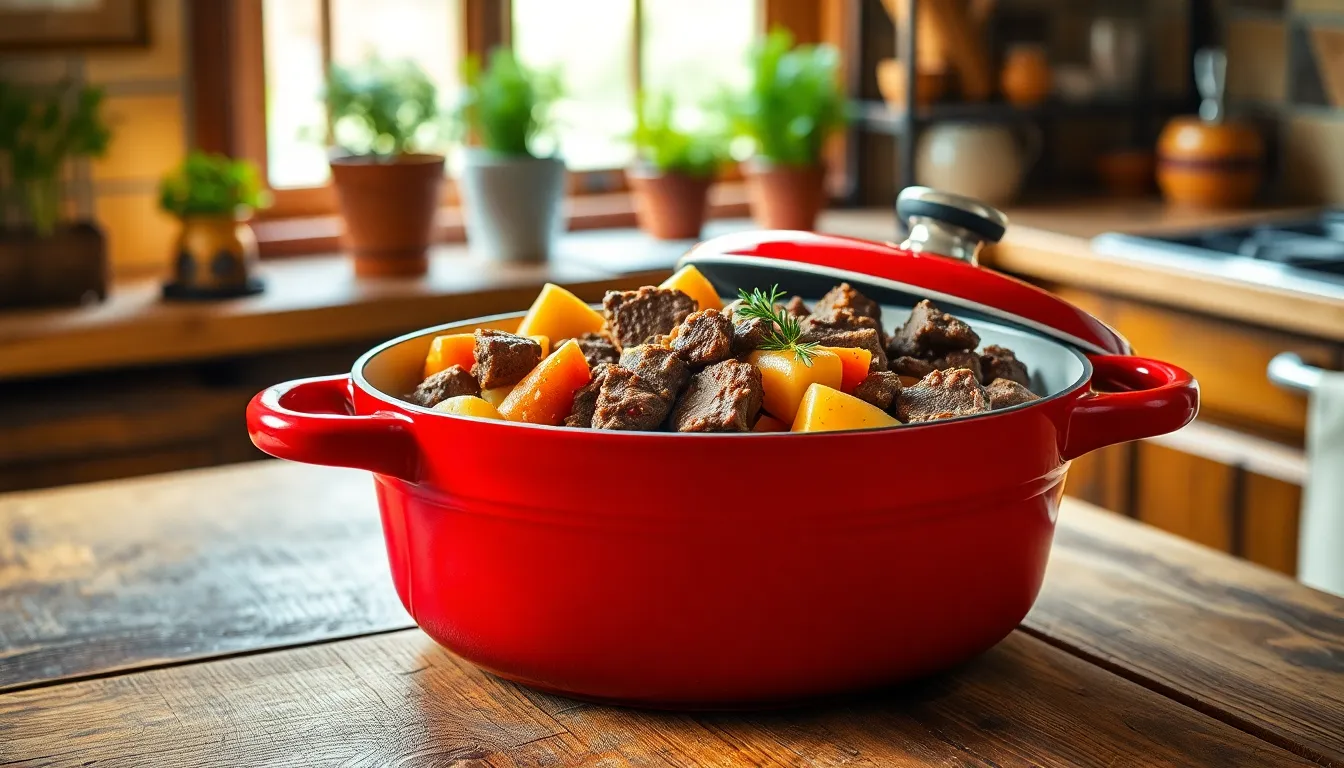Wondering what to cook in a Dutch oven? This versatile kitchen workhorse transforms ordinary ingredients into extraordinary meals with its unique heat retention and distribution properties.
From crusty artisan bread to fall-off-the-bone braised meats, your Dutch oven handles it all. Whether you’re simmering a hearty beef stew, baking a golden apple cobbler, or slow-cooking the perfect pot roast, this centuries-old cooking vessel delivers consistent results. Its heavy lid traps moisture while the thick walls maintain steady temperature—ideal for both stovetop and oven recipes that require long, slow cooking methods.
What Is a Dutch Oven and Why Use It?
A Dutch oven is a heavy-duty cooking pot with thick walls and a tight-fitting lid. It’s designed to retain and distribute heat evenly, making it perfect for a wide range of cooking techniques from braising to baking.
Types of Dutch Ovens
Dutch ovens come in several variations to suit different cooking needs. Cast iron Dutch ovens are the most traditional type, offering exceptional heat retention and durability that can last for generations with proper care. Enameled cast iron models combine the heat properties of cast iron with a non-reactive, easy-to-clean surface that doesn’t require seasoning. Ceramic Dutch ovens provide excellent heat distribution and are typically lighter than their cast iron counterparts. Aluminum and stainless steel versions offer lightweight alternatives that heat up quickly but may not retain heat as effectively as cast iron. Camping Dutch ovens feature legs and a flat lid designed for outdoor cooking with coals or campfires.
Benefits of Dutch Oven Cooking
Dutch oven cooking transforms ordinary ingredients into extraordinary meals through its unique design features. The consistent heat distribution creates ideal conditions for developing complex flavors in soups, stews, and braises. Its versatility allows you to sear, simmer, fry, roast, and bake all in one pot, minimizing cleanup and dishwashing. The tight-fitting lid traps moisture during cooking, ensuring meats remain tender and juicy even through long cooking processes. Dutch ovens work on multiple heat sources including stovetops, ovens, and even open flames, making them adaptable to various cooking situations. The excellent heat retention means your food stays warm longer when serving and requires less energy once cooking temperature is reached.
Essential Dutch Oven Recipes Every Cook Should Know
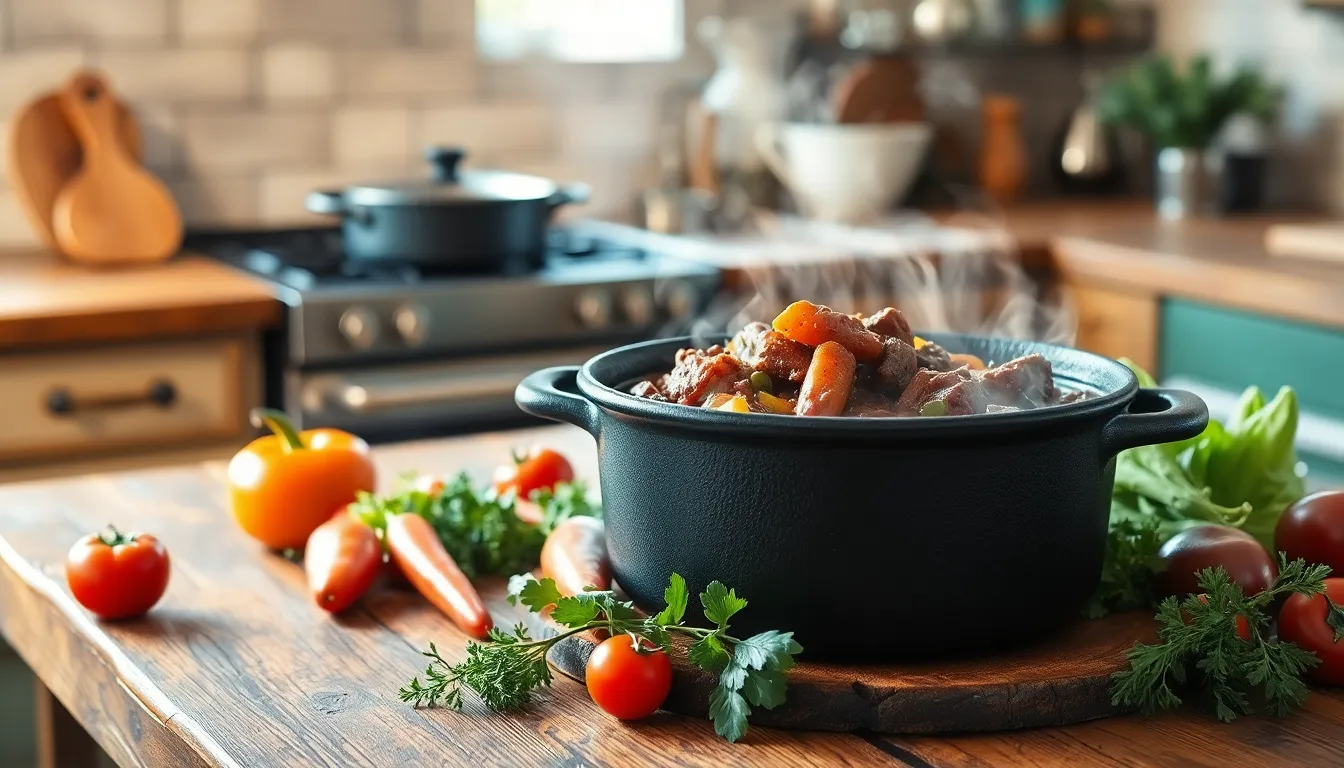
Dutch ovens transform ordinary ingredients into extraordinary meals with their exceptional heat retention properties. These versatile cooking vessels excel at creating deeply flavored dishes that satisfy and impress.
One-Pot Meals and Stews
Hearty stews shine when prepared in a Dutch oven, as the even heat distribution creates tender meat and well-developed flavors. Beef stew or lamb stew benefit from the slow-cooking environment that Dutch ovens provide, resulting in melt-in-your-mouth textures. Braised meats like chicken, beef, or lamb become incredibly tender and flavorful when cooked in this method, absorbing all the aromatics in the pot.
Thai Green Curry makes a quick yet impressive meal in your Dutch oven, combining chicken with curry paste, coconut milk, and fragrant Thai basil. For vegetarian options, black bean chili or vegetarian chili offer satisfying weeknight dinner answers that develop complex flavors as they simmer. The thick walls of the Dutch oven maintain consistent temperature throughout the cooking process, allowing ingredients to meld together perfectly.
Artisan Breads and Baked Goods
No-Knead Bread represents one of the most popular Dutch oven recipes, creating bakery-quality results at home with minimal effort. The enclosed environment generates steam during baking, producing a crispy, artisanal crust with a soft, airy interior that’s impossible to achieve in standard baking pans. Chewy artisan bread variations follow similar principles, resulting in moist, flavorful loaves that impress family and guests alike.
Your Dutch oven serves as an excellent vessel for other baked goods beyond bread. Fresh tomato sauce simmers to perfection, concentrating flavors for pasta or pizza applications. Beans—including pinto and black varieties—cook evenly and thoroughly, making excellent sides or foundations for homemade refried beans. Classic French ratatouille starts on the stovetop and finishes in the oven, showcasing the Dutch oven’s versatility across cooking methods. Lemon Coconut Salmon Curry offers a nutritious dinner option that combines tender salmon with creamy coconut milk and savory glazed bacon for a restaurant-quality meal at home.
Meat Dishes Perfect for Dutch Oven Cooking
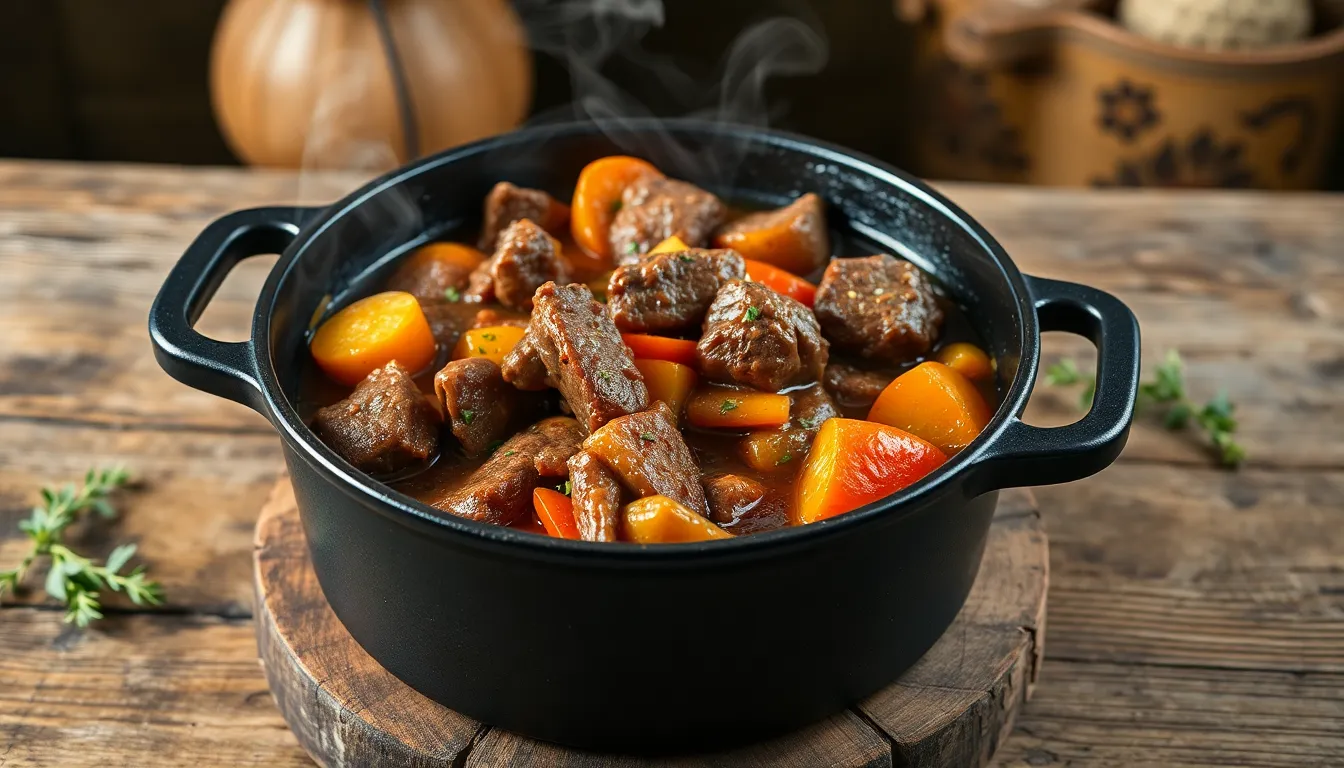
Dutch ovens excel at transforming tough cuts of meat into tender, flavorful dishes through their superior heat retention and distribution. The heavy lid traps moisture while the thick walls maintain consistent temperatures, creating ideal conditions for slow-cooking and braising.
Braised Meats
Braising in a Dutch oven produces exceptionally tender meat with deep, complex flavors. Classic beef stew combines chunks of beef with vegetables and sometimes red wine, creating a hearty, warming meal that’s perfect for cold weather days. The slow cooking process breaks down collagen in the meat, resulting in fork-tender bites surrounded by rich, savory sauce.
Braised Dutch oven steak with mushroom gravy offers a restaurant-quality dinner experience at home. This dish starts with searing the steak to lock in juices, then slowly cooking it with mushrooms before finishing with a velvety gravy that complements the meat perfectly.
For something more elegant, try braised lamb shanks with balsamic vinegar. The slow cooking transforms these tough cuts into fall-off-the-bone tender meat, while the balsamic vinegar adds a subtle sweetness and depth that balances the rich lamb flavor.
Pot roast stands as a comfort food staple that showcases the Dutch oven’s capabilities. A tough beef roast becomes remarkably tender when cooked slowly in flavorful liquid with aromatic vegetables and herbs, creating a complete one-pot meal that’s both satisfying and simple.
Roasts and Whole Chickens
Cooking a whole chicken in a Dutch oven (often called chicken en cocotte) produces juicy meat with crispy skin that’s difficult to achieve with other cooking methods. The Dutch oven creates an environment where the chicken cooks evenly while retaining moisture, resulting in a succulent bird that pairs beautifully with roasted potatoes and carrots.
Dutch oven roast chicken provides a foolproof method for perfectly cooked poultry every time. By seasoning a whole chicken and roasting it over a bed of vegetables, you’ll get crispy skin outside and moist, tender meat inside. The vegetables below absorb the flavorful drippings, creating a built-in side dish that complements the main course.
Soups and Stews That Shine in a Dutch Oven
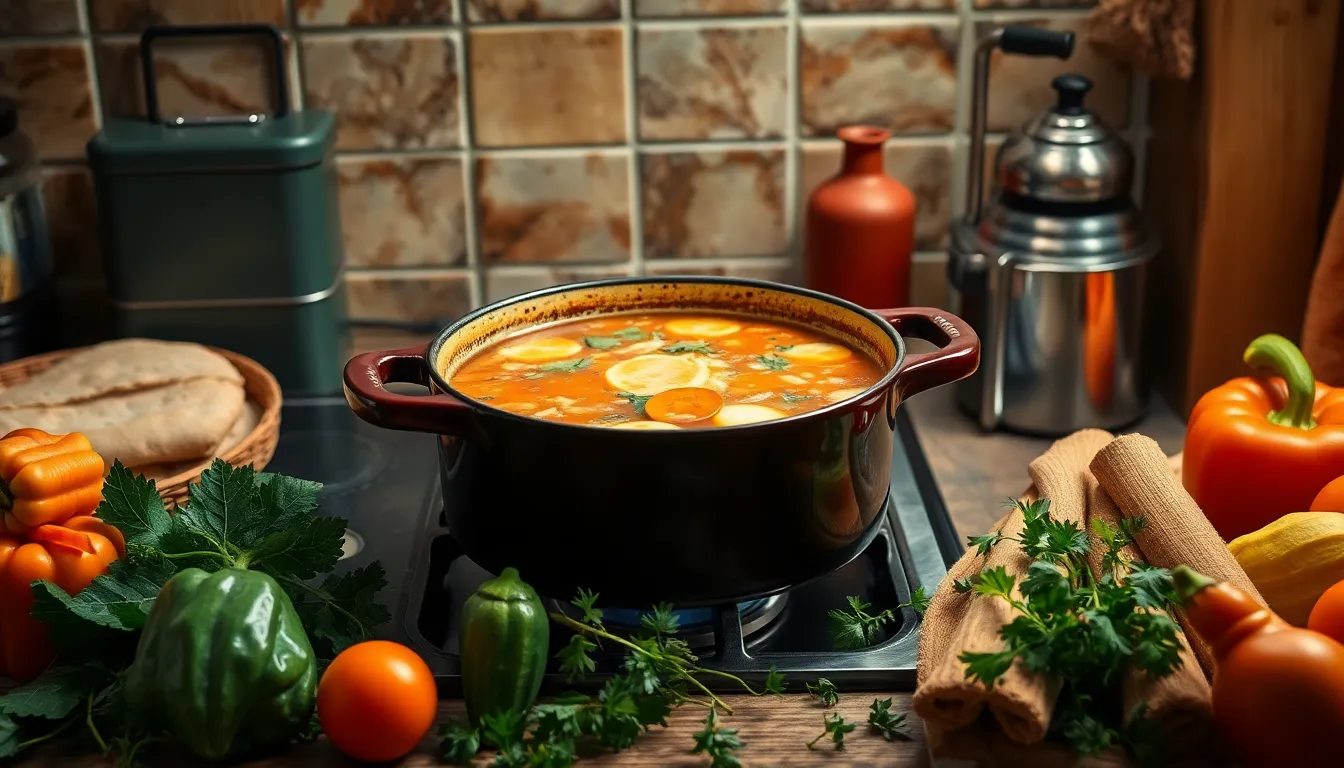
Dutch ovens excel at creating soups and stews with rich, deep flavors through their exceptional heat retention and even cooking properties. The thick walls and heavy lid trap moisture and maintain consistent temperatures, allowing ingredients to meld together perfectly during slow simmering.
Hearty Soups for Any Occasion
Chicken noodle soup transforms into a standout dish when prepared in a Dutch oven. Tender chicken thighs, fresh carrots, celery, and onions develop profound flavors as they simmer together with aromatic herbs. This classic comfort food can be prepared on your stovetop or even over a campfire for outdoor cooking adventures.
Sausage, kale, and potato soup combines nutritious greens with savory meat and hearty potatoes in a creamy broth. The Dutch oven’s excellent heat distribution ensures the potatoes cook evenly while the kale wilts perfectly and the sausage infuses the entire dish with rich flavor.
Lemon orzo chicken soup offers a lighter option with bright citrus notes. The pasta cooks directly in the flavorful broth, absorbing all the delicious flavors while the chicken becomes tender and juicy. It’s ready in under an hour but tastes like it simmered all day.
Seafood soups like spicy shrimp pho and cioppino benefit from the Dutch oven’s gentle, consistent heat. Delicate seafood ingredients cook to perfect tenderness without overcooking, while herbs and spices infuse the broth with complex flavors.
Rich, Satisfying Stews
Cowboy stew embodies the one-pot meal concept with its robust flavors that continue to develop during slow cooking. The Dutch oven’s superior heat retention makes this hearty dish ideal for reheating, often tasting even better the second day as flavors meld further.
Beef stew showcases the Dutch oven’s browning capability before slow simmering. Searing beef chunks directly in the pot creates a flavorful foundation before adding red wine, beef broth, potatoes, celery, carrots, and peas. The result is fork-tender meat and vegetables in a rich, savory sauce.
These Dutch oven soups and stews require no special equipment beyond the pot itself, making them accessible for home cooks of all skill levels. Their adaptability to various heat sources—stovetop, oven, or campfire—adds to their appeal and versatility for everyday meals or outdoor cooking adventures.
Desserts You Didn’t Know You Could Make in a Dutch Oven
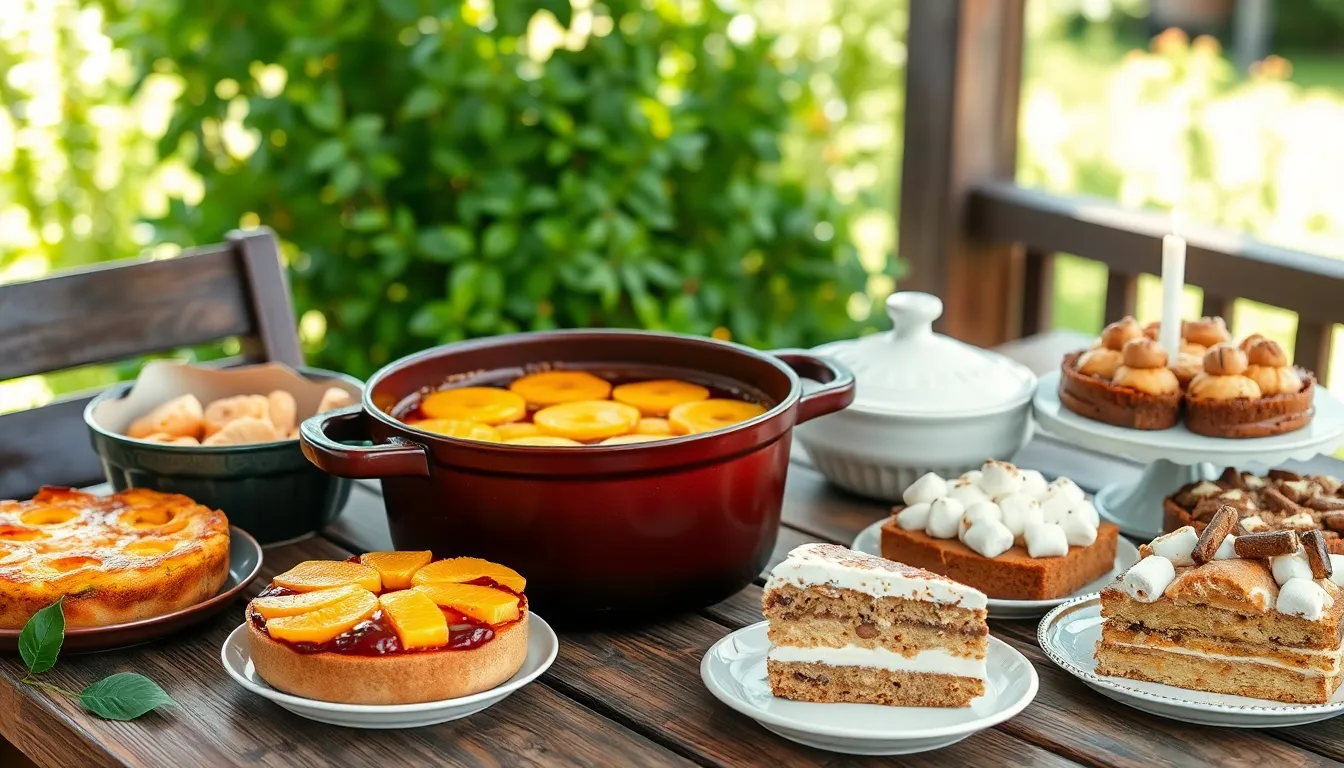
Your Dutch oven isn’t just for savory dishes—it’s a secret weapon for creating mouthwatering desserts that’ll impress family and friends. From fruity cobblers to decadent cakes, this versatile pot handles sweet treats with the same excellence it brings to stews and soups.
Cobbler ranks among the easiest Dutch oven desserts to master. Layer fresh fruits like cherries, berries, or peaches with a simple batter made from cake mix and soda, then cook over coals until the topping turns golden brown. The result combines juicy fruit with a perfectly caramelized crust that’s impossible to achieve in a standard baking dish.
Pineapple upside-down cake transforms beautifully in a Dutch oven. Arrange pineapple rings and cherries at the bottom, pour in your cake batter, and let the even heat work its magic. Flipping requires a bit of practice, but the caramelized fruit topping makes every attempt worthwhile.
Chocolate turtle cake elevates your outdoor cooking experience with layers of cake batter, chocolate chips, and rich caramel sauce. This gourmet-level dessert proves that Dutch oven cooking doesn’t limit your culinary creativity—it enhances it.
S’mores cake brings campfire flavors together in one delicious package. Start with a pre-baked angel food cake, then layer it with graham crackers, chocolate bars, and marshmallows. The Dutch oven’s heat toasts the marshmallows perfectly while melting the chocolate into a gooey delight.
Blackberry dumplings offer a unique twist on traditional fruit desserts. The lemony dumplings float atop sweet blackberry filling, creating a contrast of textures that’s especially delicious when topped with freshly whipped cream.
Chocolate dump cake lives up to its name—simply dump cherries and chocolate cake ingredients into your Dutch oven and let it cook. With minimal effort, you’ll create a rich, fudgy dessert that serves a crowd.
Strawberry rhubarb crisp showcases seasonal produce with its beautiful red filling and golden oat topping. The Dutch oven’s consistent heat ensures the rhubarb cooks properly while maintaining the strawberries’ fresh flavor, making this a standout dessert for spring and summer gatherings.
Dutch Oven Cooking Techniques and Tips
Dutch ovens deliver exceptional results through exact cooking methods that maximize their heat retention and distribution capabilities. Mastering these techniques transforms simple ingredients into memorable meals while extending the life of your cookware.
Temperature Management
Proper heat control is essential for Dutch oven cooking success. Preheat your Dutch oven before adding ingredients to prevent sticking and ensure even cooking throughout your dish. When cooking with charcoal outdoors, use approximately two briquettes per inch of Dutch oven diameter—for a 12-inch Dutch oven, that means about 14 coals on top and 8 below to maintain a temperature around 300°F. For each additional 25°F needed, add one preheated briquette to both the top and bottom of your setup.
Place twice as many coals on the lid as underneath the pot to create even heat distribution. Arrange the coals evenly around the perimeter and center, then rotate both the pot and lid every 15 minutes to eliminate hot spots. Foods requiring longer cooking times belong at the bottom of the Dutch oven where they’ll receive consistent heat. Avoid rapid temperature changes, particularly with enameled Dutch ovens, as this can cause the enamel to crack—always use oil or butter in the pan before heating to protect the cooking surface.
Cleaning and Maintenance
Proper care extends your Dutch oven’s lifespan and improves its cooking performance over time. After cooking, clean your cast iron Dutch oven with hot water and a stiff brush—skip the soap as it removes the valuable seasoning that builds up with use. This seasoning creates a natural non-stick surface that improves with each use, making your Dutch oven increasingly versatile.
Dry your Dutch oven thoroughly after washing to prevent rust formation. Apply a light coat of oil to the interior surface after cleaning to maintain the seasoning and protect the metal. Traditional cast iron Dutch ovens develop a patina over time that enhances their cooking properties—this darkened surface isn’t dirt but rather a sign of a well-loved and properly maintained pot. With proper care, your Dutch oven becomes more than cookware—it becomes a kitchen heirloom that delivers better results with each use.
Outdoor Dutch Oven Cooking
Outdoor Dutch oven cooking transforms ordinary camping meals into memorable culinary experiences. Mastering this versatile cooking method lets you prepare an impressive range of dishes while enjoying the great outdoors.
Key Points
Setting up your outdoor Dutch oven requires proper preparation for optimal results. Heat charcoal in a firepan until the coals turn almost white, then strategically place some underneath the oven and others on top to create an effective oven-like environment.
Temperature control becomes intuitive once you understand the relationship between coal quantity and heat level. For a standard 12-inch Dutch oven, using 21 coals (14 on top and 7 underneath) creates approximately 350°F cooking temperature – perfect for most recipes.
Regular rotation ensures your dishes cook evenly without developing hot spots. Turn both the lid and body of your Dutch oven every 15 minutes to maintain consistent heat distribution throughout the cooking process.
Recipes
Pasta Dish
This one-pot pasta creation combines dry pasta, olive oil, and flavorful ingredients for a satisfying outdoor meal. Mix in olives, sundried tomatoes, pepperoncini, mozzarella, havarti cheese, bell peppers, and pepperoni in a greased 12-inch Dutch oven. Cook this delicious combination over 10-12 coals with 15-18 coals placed on top for perfect doneness.
Chicken Dish
Tender, flavorful chicken emerges from this simple yet impressive recipe. Combine chicken pieces with fresh vegetables like zucchini and Roma tomatoes, then add your favorite sauce in a properly greased oven. Slow-cook this hearty meal over 8 coals with 14 coals on the lid for approximately two hours until the chicken becomes perfectly tender.
Summer Fruit Cobbler
Satisfy your sweet tooth with this delightful dessert option that showcases seasonal fruits. Start with fresh or frozen peaches combined with sugar, flour, and butter in a well-greased Dutch oven. Top this mixture with a simple cobbler batter, then cook using the appropriate number of coals based on your desired temperature until bubbly and golden.
Pizza
Dutch oven pizza provides a fun cooking activity with impressive results. Create this crowd-pleaser using basic pizza dough topped with your preferred sauce, cheese, and toppings. Follow similar cooking principles as the pasta dish, adjusting coal placement to ensure a crispy crust and perfectly melted cheese.
Conclusion
Your Dutch oven is truly the most versatile tool in your kitchen arsenal. From hearty stews and crusty breads to succulent roasts and decadent desserts this culinary workhorse delivers exceptional results with minimal effort. Whether you’re cooking in your kitchen or over a campfire your Dutch oven creates the perfect environment for flavors to develop and ingredients to transform.
As you explore the endless possibilities remember that mastering temperature control and proper maintenance will ensure your Dutch oven serves you for generations. Start with simple recipes then expand your repertoire as you gain confidence.
Ready to elevate your cooking? Grab your Dutch oven and let the magic begin. You’ll wonder how you ever cooked without it.
Frequently Asked Questions
What is a Dutch oven?
A Dutch oven is a heavy-duty cooking pot with thick walls and a tight-fitting lid designed for excellent heat retention and distribution. Typically made of cast iron (traditional or enameled), it can also come in ceramic, aluminum, or stainless steel versions. This versatile pot can be used for braising, baking, roasting, frying, and slow cooking on multiple heat sources including stovetops, ovens, and even campfires.
What can I cook in a Dutch oven?
You can cook nearly anything in a Dutch oven! Popular dishes include soups, stews, braises, no-knead bread, pasta dishes, pot roasts, and even desserts like cobblers and cakes. The pot excels at slow-cooking methods that develop deep flavors, but it’s equally capable of baking, frying, and even cooking outdoors. Its versatility makes it perfect for one-pot meals that minimize cleanup while maximizing flavor.
Why are Dutch ovens so expensive?
Dutch ovens, particularly high-quality cast iron ones, are expensive because of their durable construction, superior materials, and labor-intensive manufacturing process. Enameled Dutch ovens require additional processing to apply and fire the enamel coating. Their longevity (often lasting generations), versatility across cooking methods, and consistent performance justify the investment. Less expensive alternatives exist, but may not offer the same heat retention, durability, or cooking performance.
How do I clean and maintain my Dutch oven?
For enameled Dutch ovens, wash with warm soapy water and avoid metal utensils or abrasive cleaners. For traditional cast iron, clean with hot water and a stiff brush (no soap), dry thoroughly, and apply a light coat of oil after each use to maintain seasoning. Never soak cast iron or put it in the dishwasher. Regular maintenance will extend your Dutch oven’s lifespan and improve its cooking performance.
Can I use my Dutch oven on any heat source?
Most Dutch ovens are adaptable to multiple heat sources. Cast iron Dutch ovens work on gas, electric, and induction stovetops, in ovens, and over campfires. Enameled cast iron is similarly versatile but should not be used over open flames to protect the enamel coating. Always check manufacturer guidelines, as some specialized Dutch ovens may have restrictions for certain heat sources.
What size Dutch oven should I buy?
For most households, a 5-6 quart Dutch oven offers the best versatility. This size accommodates family meals (4-6 servings) while remaining manageable to handle. If you frequently cook for larger groups, consider a 7-8 quart model. For individuals or couples, a 3.5-4 quart pot may suffice. When deciding, consider storage space, typical recipes, and the weight you can comfortably lift when the pot is full.
Can I bake bread in a Dutch oven?
Absolutely! Dutch ovens are perfect for baking artisan-style bread. The enclosed space creates steam from the bread’s moisture, developing a crispy crust and airy interior similar to professional bakery results. No-knead bread recipes are particularly popular for Dutch ovens. Preheat the pot in the oven, add your shaped dough, and bake with the lid on initially, then remove it to brown the crust.
How do I cook with a Dutch oven outdoors?
For outdoor cooking, place your Dutch oven on a stable surface and arrange charcoal briquettes beneath and on top of the lid for even heating. As a general rule, use twice as many briquettes as the diameter of your pot in inches. Place ⅓ underneath and ⅔ on the lid. Rotate the pot and lid 90 degrees in opposite directions every 15 minutes for even cooking. Always use heatproof gloves and lid lifters for safety.
What desserts can I make in a Dutch oven?
Dutch ovens excel at desserts! Popular options include fruit cobblers, crisps, and dump cakes that develop perfect caramelization. Try pineapple upside-down cake, s’mores cake, blackberry dumplings, or strawberry rhubarb crisp. The even heat distribution creates beautifully baked desserts with crisp edges and moist centers. These desserts are especially fun to make while camping, where the Dutch oven brings gourmet quality to outdoor cooking.
Is it worth investing in an expensive Dutch oven?
While quality Dutch ovens represent a significant investment, they offer exceptional value over time. High-end models from brands like Le Creuset or Staub provide superior heat retention, durability (often lasting generations), versatile cooking capabilities, and better enamel finishes that resist chipping. However, mid-range options from Lodge or Cuisinart offer good performance at lower prices. Consider how frequently you’ll use it and your cooking needs when deciding your budget.
